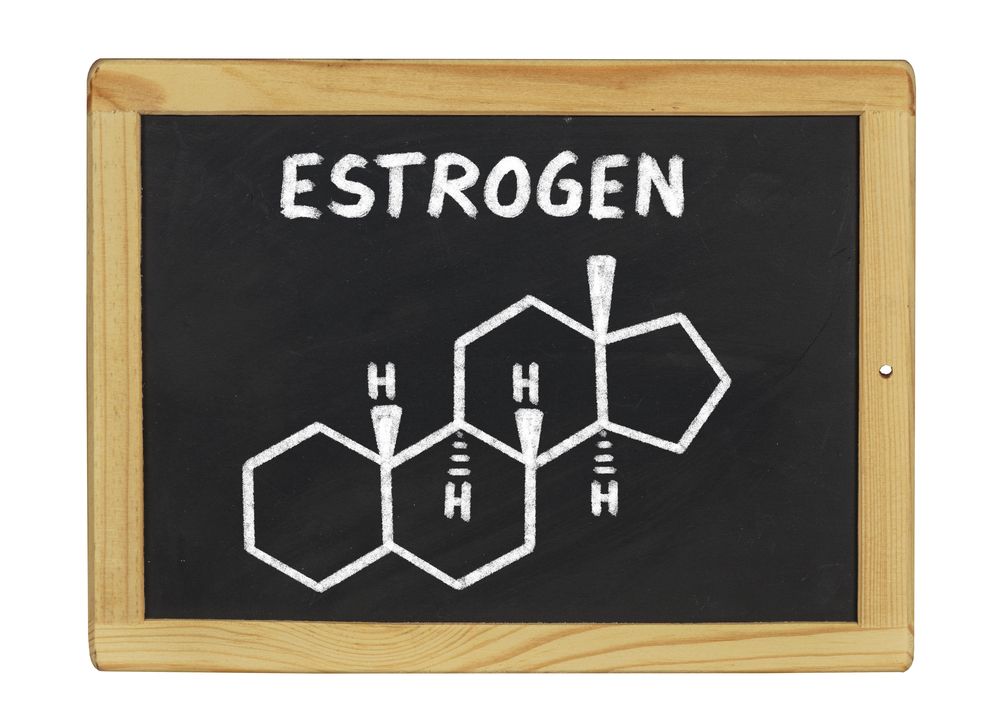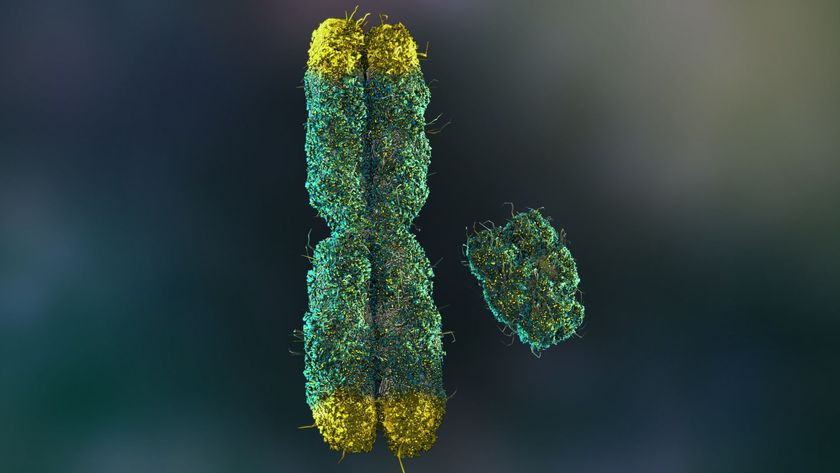What Is Estrogen?

Estrogens are hormones that are important for sexual and reproductive development, mainly in women. They are also referred to as female sex hormones. The term "estrogen" refers to all of the chemically similar hormones in this group, which are estrone, estradiol (primary in women of reproductive age) and estriol.
Estrogen's function
In women, estrogen is produced mainly in the ovaries. Ovaries are grape-sized glands located by the uterus and are part of the endocrine system.
Estrogen is also produced by fat cells and the adrenal gland. At the onset of puberty, estrogen plays a role in the development of so-called female secondary sex characteristics, such as breasts, wider hips, pubic hair and armpit hair.
Estrogen also helps regulate the menstrual cycle, controlling the growth of the uterine lining during the first part of the cycle. If the woman's egg is not fertilized, estrogen levels decrease sharply and menstruation begins. If the egg is fertilized, estrogen works with progesterone, another hormone, to stop ovulation during pregnancy.
During pregnancy, the placenta produces estrogen, specifically the hormone estriol. Estrogen controls lactation and other changes in the breasts, including at adolescence and during pregnancy.
Estrogen is instrumental in bone formation, working with vitamin D, calcium and other hormones to effectively break down and rebuild bones according to the body's natural processes. As estrogen levels start to decline in middle age, the process of rebuilding bones slows, with postmenopausal women eventually breaking down more bone than they produce. This is why postmenopausal women are four times more likely to suffer from osteoporosis than men, according to the Cleveland Clinic.
Estrogen also plays a role in blood clotting, maintaining the strength and thickness of the vaginal wall and the urethral lining, vaginal lubrication and a host of other bodily functions.
It even affects skin, hair, mucous membranes and the pelvic muscles, according to Johns Hopkins Medicine. For example, estrogen can make the skin darker. Some researchers hope to use this information to create safe fake tanning lotions by activating the skin darkening reaction in estrogen, without triggering other changes in the body due to the hormone.
"If you expose melanocytes to estrogen, they respond by making more melanin, but they don't have the classic estrogen receptor," Dr. Todd Ridky, senior author of a 2016 study on estrogen and skin color and an assistant professor of dermatology at the University of Pennsylvania.
The hormone also affects the brain, and studies also show that chronically low estrogen levels are linked with a reduced mood, according to the National Library of Medicine.
Men produce estrogen as well, but at lower levels than women. Estrogen in males is secreted by the adrenal glands and by the testes. In men, estrogen is thought to affect sperm count. Overweight men are more commonly affected by low sperm count due to estrogen because there is more adipose tissue in the obese, which can set off the creation of excess estrogen, according to a 2010 paper published in the Asian Journal of Andrology.
In 2011, researchers at American University in Washington, D.C., found a link between estrogen and the ability to control excessive inflammation in the brain. This research is hoped to help those with neurodegenerative disorders such as Parkinson's disease.
Estrogen can also help with ovarian cysts. "Most of the time nothing needs to be done to treat or prevent functional cysts," said Dr. Antonella Lavelanet, an obstetrician at Boston Medical Center. "However, for women who are prone to ovarian cysts, an estrogen-containing birth control may help reduce the risk of developing certain types of functional cysts, in particular cysts that occur after ovulation. Oral contraception pills and the patch or ring, which have similar mechanisms of action, can help suppress ovulation."
Changes in estrogen levels
There are many times throughout a person's life when estrogen levels may change. For example, estrogen levels naturally increase during puberty and during pregnancy. Estrogen levels fall after menopause, or when a woman stops menstruating. This reduction in estrogen production can cause symptoms such as hot flashes, vaginal dryness and loss of sex drive. Estrogen levels also decrease after childbirth.
Other conditions that can cause estrogen levels to drop include hypogonadism (or diminished function of the ovaries) and polycystic ovarian syndrome. Extreme exercise and anorexia can also cause a decrease in estrogen levels because women with low body fat may not be able to produce adequate amounts of estrogen.
Some postmenopausal women with nonalcoholic fatty liver disease (NAFLD) have long durations of estrogen deficiency. Recent research has found that this deficiency could increase the risk of having more severe fibrosis, according to a study published in the journal Hepatology.
Medications with estrogen
Estrogen is found in most oral birth control pills (along with the hormone progestin.) Estrogen helps stop ovulation during pregnancy, and birth control pills mimic this effect by regulating the levels of estrogen and thereby preventing ovulation from occurring.
Hormone replacement therapy — a treatment to reduce symptoms of menopause — also includes estrogen (which can be given in combination with progestin). This therapy is sometimes used to treat postmenopausal problems such as hot flashes, night sweats, anxiety, sleeping problems and vaginal atrophy, a thinning, drying and inflammation of the vaginal walls due to a decrease in estrogen, according to the U.S. National Library of Medicine.
Estrogen hormone replacement therapy is also key for transgender women to achieve breast growth, inhibit body hair growth and to create other changes that are important for transitioning from male to female. Hormone administration that uses estrogens and androgens has been used for over 50 years as an effective in treatment for gender dysphoria, according to the University of California. Sublingual, transdermal and injectable estrogen hormones are preferable for the treatment of transwomen and may be combined with other drugs such as anesthetics for hair removal, anti-androgens and progesterone.
Estrogen side effects
While there are many benefits to estrogen, it can be a bad thing in some cases. For example, elevated estrogen levels may cause an increased risk for injury. A 2016 study published in the journal Medicine & Science in Sports & Exercise found that the risk of ligament injury may be mitigated by the use of oral contraceptives.
The majority of breast cancers are also sensitive to estrogen, meaning that estrogen promotes tumor growth. These cancers are called hormone receptor positive breast cancers. For people with these cancers, treatments to lower estrogen levels or block estrogen production can be used to help prevent cancer recurrence after surgery, or to slow cancer growth.
According to Breast Cancer.org, alcohol can increase a woman's risk of hormone-receptor-positive breast cancer. Alcohol also enhances the effects of estrogen in driving the growth of breast cancer cells, according to 2016 research at the University of Houston.
Endometriosis is another estrogen-dependent disease. Reducing estrogen levels and providing non-estrogen treatments have all been considered for the treatment of endometriosis. The problem is that reducing the levels of estrogen in women can lead to infertility.
A study by the Women's Health Initiative showed that hormone replacement therapy — both solely estrogen and estrogen-and-progestin — had significant risks. It increased the risk of breast cancer, stroke and blood clots and did not, as predicted, lower the risk of heart disease. Given the danger, hormone replacement therapy should be prescribed on a case-by-case basis. It is currently approved for postmenopausal symptoms, though women who do start hormone replacement therapy are encouraged to try the smallest dose for the shortest amount of time, according to the Food and Drug Administration. Only women with a severe risk of osteoporosis who cannot take non-estrogen therapies should be considered for using hormone replacement therapy preventatively.
Live Science Contributor Jessie Szalay and staff writer Rachael Rettner contributed to this article.
Additional resources
Sign up for the Live Science daily newsletter now
Get the world’s most fascinating discoveries delivered straight to your inbox.













